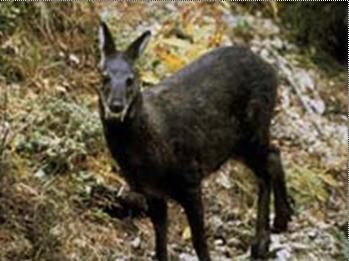| Citation |
Wang, Y. & Harris, R. 2015. Moschus fuscus . The IUCN Red List of Threatened Species 2015: e.T13896A61977357. https://dx.doi.org/10.2305/IUCN.UK.2015-4.RLTS.T13896A61977357.en. Downloaded on 06 February 2020. |
Description |
JUSTIFICATION
This species is listed as Endangered because of a probable serious population decline, suspected to be more than 50% over the last three generations (approximately 21 years), caused by over-exploitation, shrinkage in distribution, habitat destruction and degradation. Although there are no direct data available regarding recent declining population rates, the above-mentioned rate of decline seems reasonable based on the high levels of harvesting and habitat loss. It should also be noted that it has a relatively restricted range. No new information was received in 2014 to enable full re-assessment of this species.
RANGE DESCRIPTION
This species occurs in China (northwestern Yunnan and southeastern Tibet), northern Myanmar, northeastern India (Arunachal Pradesh), Bhutan and eastern Nepal (Grubb 2005). It is reported at elevations of 2,600-4,200 m asl. Within Yunnan, China, it is distributed in Gongshan, Fugong and Bijiang counties (Wang unpublished data 2008).
DESCRIPTION
Estimating population size or trend for Musk Deer is very difficult, and has rarely been done satisfactorily. Population estimates over large-scale areas are subject to considerable uncertainty (and this is exacerbated by uncertainty over taxonomy). No rigorous population estimates exist within China. According to Wang (1998), this species is very rare, making up less than 10% of Musk Deer found even within Yunnan, with even fewer reported from Tibet. Yang et al. (2003) considered the species quite rare, perhaps on the verge of extinction. This species is very rare within Myanmar (Than Zaw pers. comm.). Musk glands were exported from Myanmar, and there have been many skin samples from Myanmar as well. This species was recorded via camera-trap photos between 2008 and 2010 in Khangchendzonga Biosphere Reserve, Sikkim, India (Sathyakumar et al. 2011). There is also one recent camera trap record from Khakaborazi National Park, Myanmar (Than Zaw pers. comm.).
HABITAT AND ECOLOGY
This species is found near the tree line in Rhododendron and coniferous forests, forest-edge and rocky ridges at high elevations (2,600-4,200 m asl). This is a poorly-known form; all life-history attributes are likely similar to those of the Alpine Musk Deer (M. chrysogaster).
THREATS
The musk produced by this genus of primitive deer is highly valued for its cosmetic and alleged pharmaceutical properties, and can fetch U.S.$45,000 per kilogram (2.2 pounds) on the international market. Although this musk, produced in a gland of the males, can be extracted from live animals, most "musk-gatherers" kill the animals to remove the entire sac, which yields only about 25 grams (1/40 of a kilogram) of the brown waxy substance. Such poaching is relatively easy to accomplish and difficult to stop using only legal means (Harris 2007). There is hunting and illegal trade for musk glands from Myanmar to China (Than Zaw pers. comm.). The threat from trade is increasing (Than Zaw pers. comm.).
Musk Deer appear to require dense vegetation, either in the form of intact forests or shrublands; thus excessive forest clearing or grazing can preclude Musk Deer from using such lands (Yang et al. 2003).
USE AND TRADE
The musk produced by this genus of primitive deer is highly valued for its cosmetic and alleged pharmaceutical properties, and can fetch U.S.$45,000 per kilogram (2.2 pounds) on the international market.
CONSERVATION ACTIONS
This species is listed on CITES Appendix II in China, and on Appendix I in the other countries within its range. It is on the China Red List as Critically Endangered (A1acd+B1ab(i,ii,iii)), and the China Key List as category II. This species has become nominally protected in Myanmar with the creation Khakaborazi National Park, but enforcement of hunting has a long way to go (Than Zaw and J.W. Duckworth pers. comm.). |

